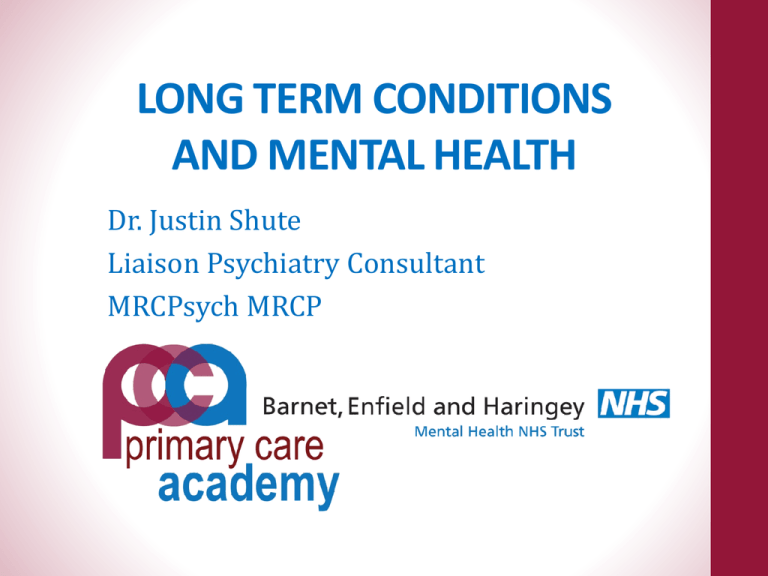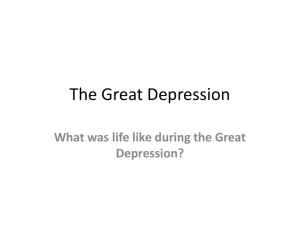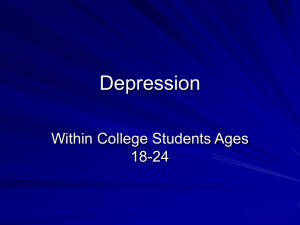Presentation Long Term Conditions and Mental Health
advertisement

LONG TERM CONDITIONS AND MENTAL HEALTH Dr. Justin Shute Liaison Psychiatry Consultant MRCPsych MRCP LTCs Long Term conditions 30% of the population of England (c. 15.4m people) 30% (c. 4.6m) of those with an LTC have a mental health problem MH PROBLEMS Mental health problems 20% of the population of England (c. 10.2m people) 46% (c.4.6m) of those with a mental health problem have an LTC Naylor Parsonage et al 2012 based on Crimpean and Drake 2011 People with LTCs 2-3 X more Likely to have Mental Illness Depression 2-3 X more common in cardiac disease, coronary artery disease, stroke, angina, congestive heart failure, or following a heart attack • Fenton and Stover 2006; Benton et al 2007; Gunn et al 2010; Welch et al 2009 Prevalence between 20 & 50% But 2-3 X increase compared with controls is consistent across studies People with LTCs 2-3 X more Likely to have Mental Illness Diabetes 2-3 X more likely to have depression than the general population • Fenton and Stover 2006; Simon et al 2007; Vamos et al 2009 Chronic obstructive pulmonary disease 3 X more mental illness than general population • NICE 2009 Anxiety disorders are very common; panic disorder 10 X • Livermore et al 2010 World Health Surveys: 2 or more LCTs 7X more likely to have depression than people without LCT • Moussavi et al 2007 Does It Really Matter ? Cardiovascular patients with depression experience 50% more acute exacerbations per year and have higher mortality rates • Katon 2003 Depression leads to 2-3 X negative outcomes for people with acute coronary syndromes • Barth et al 2004 Depression increases mortality rates after heart attack by 3-5 X • Lesperance et al 2002 Does It Really Matter ? 2 X mortality after heart bypass surgery over an average follow-up period of 5 years • Blumenthal et al 2003 Chronic heart failure 8 X more likely to die within 30 months if they have depression • Junger et al 2005 People with diabetes & depression 36-38% increased risk of all-cause mortality over a 2 year follow-up period • Katon et al 2004 Poorer glycaemic control, more diabetic complications and lower medication adherence • Das-Munshi et al 2007 Does It Really Matter ? Relationship between LTCs and mental illness is exacerbated by socio-economic deprivation: greater proportion of people in poorer areas have multiple long term conditions effect of this multi-morbidity on mental health is stronger when deprivation is also present Why are Outcomes Worse ? Co-morbid mental health problems impair active self-management Reduced motivation and energy for selfmanagement leads to poorer adherence to treatment plans DiMatteo et al 2000 Cardiac patients, depression increases adverse health behaviours (eg. physical inactivity) and decrease adherence to self-care regimens such as smoking cessation, dietary changes and cardiac rehabilitation programmes Benton et al 2007; Katon 2003 Poorer dietary control and adherence to medication Vamos et al 2009 Prevention Befriending Debt advice Wellbeing in the workplace initiatives • Knapp et al 2011 Hampered by “hard wired separation of physical and mental health care” Principles for Assessment • When assessing a patient with a chronic physical health problem who may have depression, conduct a comprehensive assessment that does not rely simply on a symptom count. • Take into account: – the degree of functional impairment and/or disability associated with the possible depression and – the duration of the episode. The stepped-care model Focus of the intervention STEP 4: Severe and complex1 depression; risk to life; severe selfneglect STEP 3: Persistent subthreshold depressive symptoms or mild to moderate depression with inadequate response to initial interventions; moderate and severe depression STEP 2: Persistent subthreshold depressive symptoms; mild to moderate depression STEP 1: All known and suspected presentations of depression 1,2 see slide notes Nature of the intervention Medication, high-intensity psychological interventions, electroconvulsive therapy, crisis service, combined treatments, multiprofessional and inpatient care Medication, high-intensity psychological interventions, combined treatments, collaborative care2, and referral for further assessment and interventions Low-intensity psychosocial interventions, psychological interventions, medication and referral for further assessment and interventions Assessment, support, psycho-education, active monitoring and referral for further assessment and interventions Case identification and recognition • Be alert to possible depression – Particularly in patients with a past history of depression or – a chronic physical health problem with associated functional impairment. • Consider asking patients who may have depression two questions, specifically: – During the last month, have you often been bothered by feeling down, depressed or hopeless? – During the last month, have you often been bothered by having little interest or pleasure in doing things? Low-intensity psychosocial interventions For patients with: • persistent sub-threshold depressive symptoms or mild to moderate depression and a chronic physical health problem • Sub-threshold depressive symptoms that complicate care of chronic physical health problem Consider offering one or more of the following interventions, guided by patient preference: ‐ structured group physical activity programme ‐ group-based peer support (self-help) programme ‐ individual guided self-help based on CBT ‐ computerised CBT. Treatment for moderate depression For patients with initial presentation of moderate depression and a chronic physical health problem: • offer the following choice of high intensity psychological interventions: – group-based CBT or – individual CBT or – behavioural couples therapy. Antidepressant drugs (1) • Do not use antidepressants routinely for subthreshold depressive symptoms or mild depression in patients with a chronic physical health problem • Consider antidepressants for people with: – a past history of moderate or severe depression or – mild depression that complicates the care of the physical health problem or – Sub-threshold depressive symptoms present for a long time or – Sub-threshold depressive symptoms or mild depression that persist(s) after other interventions. Antidepressant drugs (2) • When an antidepressant is to be prescribed, tailor it to the patient, and take into account: – additional physical health disorders – side effects, which may impact on the underlying physical disease – lack of evidence supporting the use of specific antidepressants for people with particular chronic physical health problems – interactions with other medications. What is collaborative care? Four essential elements collaborative definition of problems objectives based around specific problems self-management training and support services active and sustained follow up Collaborative Care Consider collaborative care for patients with: • moderate to severe depression • a chronic physical health problem with associated functional impairment whose depression has not responded to: – initial high-intensity psychological interventions or – pharmacological treatment or – a combination of psychological and pharmacological interventions. Detection > 90% of people with depression alone were diagnosed in primary care Depression detected < 25%among people with LTC • Bridges and Goldberg 1985 Majority of cases of depression among people with physical illnesses go undetected and untreated • Cepoiu et al 2008; Katon 2003 Active case-finding in people with LTCs needed • NICE 2010 Treatment Standard interventions eg. antidepressants or CBT are effective • Fenton & Stover 2006; Yohannes et al 2010, Ciechanowski et al 2000 Psychological therapy was associated with reduced emergency department attendance • De Lusigman et al 2011 Treating co-morbid mental illness by itself doesn’t always translate into improved physical symptoms • Cimpean & Drake 2011; Benton et al 2007; Perez-Prada 2011 Integration Integrating treatment for mental health and physical better than overlaying mental health interventions • Fenton & Stover 2006; Yohannes et al 2010 Adding a psychological component to COPD rehab programmes: improved completion rates and reduced re-admissions for COPD • Abell et al 2008 CBT-based disease management programme for angina = 33% fewer hospital admissions in following year, saving £1,337 per person • Moore et al 2007 Stepped Care Secondary Services 1:1 or group CBT Self help, coping skills, psycho-ed courses, CCBT, behavioural programmes What Can GPs Do ? Identify patients with co-morbidity Help patients recognise mental health problems Help patients understand links between LTC and mental health problems • “hard-wired separation of physical and mental care” Monitor uptake of psychological services by people with LTCs Identify successful and unsuccessful referral pathways Build relationships between physical and mental healthcare professionals Monitoring and Follow Up See patients started on antidepressants not at risk of suicide ‐ after 2 wks, ‐ every 2 - 4 wks for next 3 mths ‐ less frequently if response is good. If < 30 yrs (increased risk on anti depressants) see ‐ after 1 wk ‐ less frequently thereafter until no longer risk If at increased suicide risk, refer Side Effects If side effects develop: monitor symptoms closely and stop anti depressant if patient finds side effects unacceptable or change if the patient prefers; or If mild anxiety/insomnia/agitation consider benzodiazepine for 2 wks max. Caution for those ‐ at risk of falls; or ‐ with chronic anxiety When to refer Concerns about risk Inadequate response to psychological interventions Inadequate response to 1 or 2 antidepressants Atypical / complicated presentation “Gut feeling” Severity and risk will determine urgent or routine referral Where can I find out more? Pack for good practice and recovery information BEHMHT GP Intranet site – includes our more detailed treatment guidelines PCA web resources – in development NICE Guidance RCPsych website








